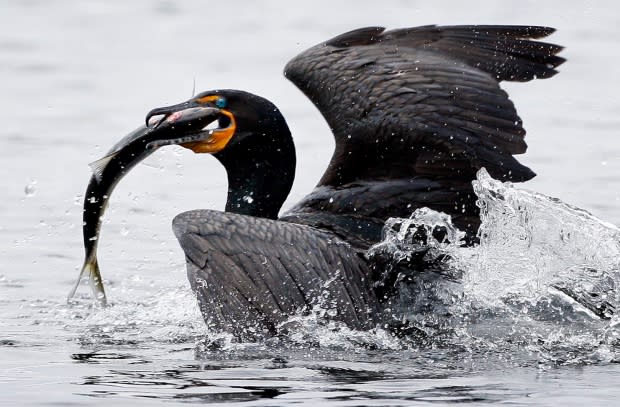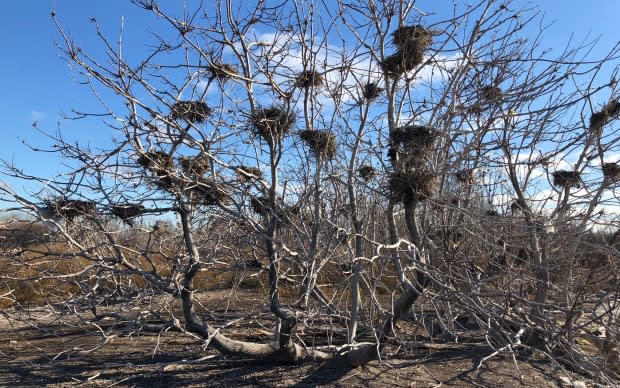Cormorant hunt lacks scientific basis, 51 experts say in open letter to Ontario minister
Fifty-one experts are calling on the Ontario minister of natural resources and forestry to provide a scientific explanation for a province-wide hunt on double-crested cormorants that is slated to begin within two weeks.
In an open letter to John Yakabuski, dated on Tuesday, the experts raise concerns about the hunt, saying it is not based on science, the province has failed to indicate what population of cormorants it considers desirable and it will not require hunters to report the numbers of birds they have killed.
The letter says "targeted, localized management approaches" should be adopted instead of a hunt and it calls on the minister and ministry to provide a "science-based, detailed and peer-reviewed approach" to resolve conflicts with cormorants.
"A hunt is not the approach that should be utilized to ensure maintaining a sustainable population of cormorants in Ontario," reads the letter.
Cormorants are aquatic, fish-eating birds that came close to being endangered a century ago, but their populations have since rebounded. The province has said the hunt is necessary because the birds deplete fish stocks and their droppings damage trees. Toronto's Tommy Thompson Park is said to have one of the largest cormorant populations in North America.
In a statement, Ministry of Natural Resources and Forestry spokesperson Maimoona Dinani said the province has been hearing concerns from property owners, commercial fishers and hunters and anglers about the kind of damage cormorants have caused their communities.
"So the ministry is taking steps to help them deal with any local issues," Dinani said. "Cormorants prey on fish, eating a pound a day. Research shows they can impact some fish stocks."
Dinani also said the birds can damage trees they nest and roost in, while their droppings can kill trees and destroy traditional nesting habitats for other water birds.
"Ontario currently has a healthy and sustainable cormorant population. The ministry will continue to monitor the double-crested cormorant population status and trends to support sustainability of cormorants in the province."
Experts who signed the letter include ecologists, fisheries scientists and natural resources managers from Canada and the U.S. Thirty-eight of them have PhDs.
Gail Fraser, a York University professor in the faculty of environmental and urban change who put together and signed the letter, said on Tuesday that the Ontario government has failed to look at cormorants in their complexity and is allowing the hunt to appease some members of the public who do not like the birds.

"The point of the letter is to express our concern that the ministry is undertaking a cormorant hunt that has no scientific basis to it. We're asking them to stop the hunt and come up with a plan that's based on science," Fraser said.
Fraser said a management plan is needed that uses existing literature, studies and best practices on cormorants.
"We think there is no science that backs that a hunt should be used for this species," she said.
Such a management plan should be justified, explain where its activities will take place, have specific goals, indicate how it will resolve conflicts with cormorants and identify which fisheries might be at risk, she said.
"It's not good enough to just say they damage trees," she said.
"It's completely irresponsible and it's a mismanagement of the species," she said. "A provincial wide hunt is a huge mistake."
Asked where the hunt will be allowed to take place, Dinani said that many municipalities have bylaws that restrict the discharge of firearms within their boundaries for public safety.
"For example, both Toronto and Hamilton have a no discharge of weapon by-law within city limits."
Hunters with licences allowed to kill up to 15 birds a day
The letter says the hunt fails to abide by two of seven principles of the North American model of wildlife conservation. According to one principle, wildlife should be killed for legitimate purposes, and according to another, scientific management is the proper way to conserve wildlife.
The birds will not be eaten after they are killed.
The Ontario ministry announced the hunt on July 31, calling it a "fall harvest," and said it will allow a hunter with an outdoors card and small game licence to kill up to 15 birds a day from Sept. 15 to Dec. 31. Hunters will be allowed to shoot the birds from stationary motorboats.

"The harvest will help address concerns about impacts to local ecosystems by cormorants, a bird that preys on fish, eating a pound a day, and that can damage trees in which they nest and roost," the ministry said in a July 31 news release when it announced the hunt.
Ontario should manage species with U.S., letter says
The letter continues: "Cormorants are a species native to Ontario. A significant amount of financial resources was invested in creating a healthier environment which allowed them to recover; their abundance is a conservation success story."
To ensure the species doesn't become endangered again, the province needs to manage the population of cormorants by using the best wildlife management practices and by monitoring their populations carefully, with the help of the U.S. Fish and Wildlife Service (USFWS), the letter says.
By failing to require hunters to report the number of birds they have killed, the province will be unable to coordinate its management efforts with the USFWS, and there will be no data on the numbers of species killed that look similar to cormorants, the letter says. These species include the common loon.

According to the letter, a "science-based, detailed and peer-reviewed approach" would include:
Data on Ontario's cormorant population, such as the number of breeding birds and colonies.
An estimate of how the population will respond to "targeted localized management actions" to ensure a sustainable population.
Detailed rationales and objectives for proposed localized management activities.
An explanation on how the ministry will coordinate with the U.S. Fish and Wildlife Service in managing cormorants.
The ministry estimates there are a minimum of 143,000 breeding cormorants in 344 colonies.

But, according to the letter, if only 0.5 per cent of small game hunters reached the daily limit for 10 days, the hunt would allow the number of birds killed to exceed the province's estimated breeding population. There are an estimated 197,000 registered small game hunters and only 143,000 cormorants in Ontario.
Petition opposed to hunt garners over 3,900 signatures
Meanwhile, a change.org petition opposed to the hunt and organized by Toronto artist Cole Swanson has collected more than 3,900 signatures.
"The results of this hunt could be disastrous for both the populations of cormorants in the province, but also for birds of similar appearance," the petition reads, listing several species of loon and two species of cormorant that are rarely seen in Ontario.
"Until the scientific rigour demanded herein is demonstrated, plans for a hunt must cease," it adds.


